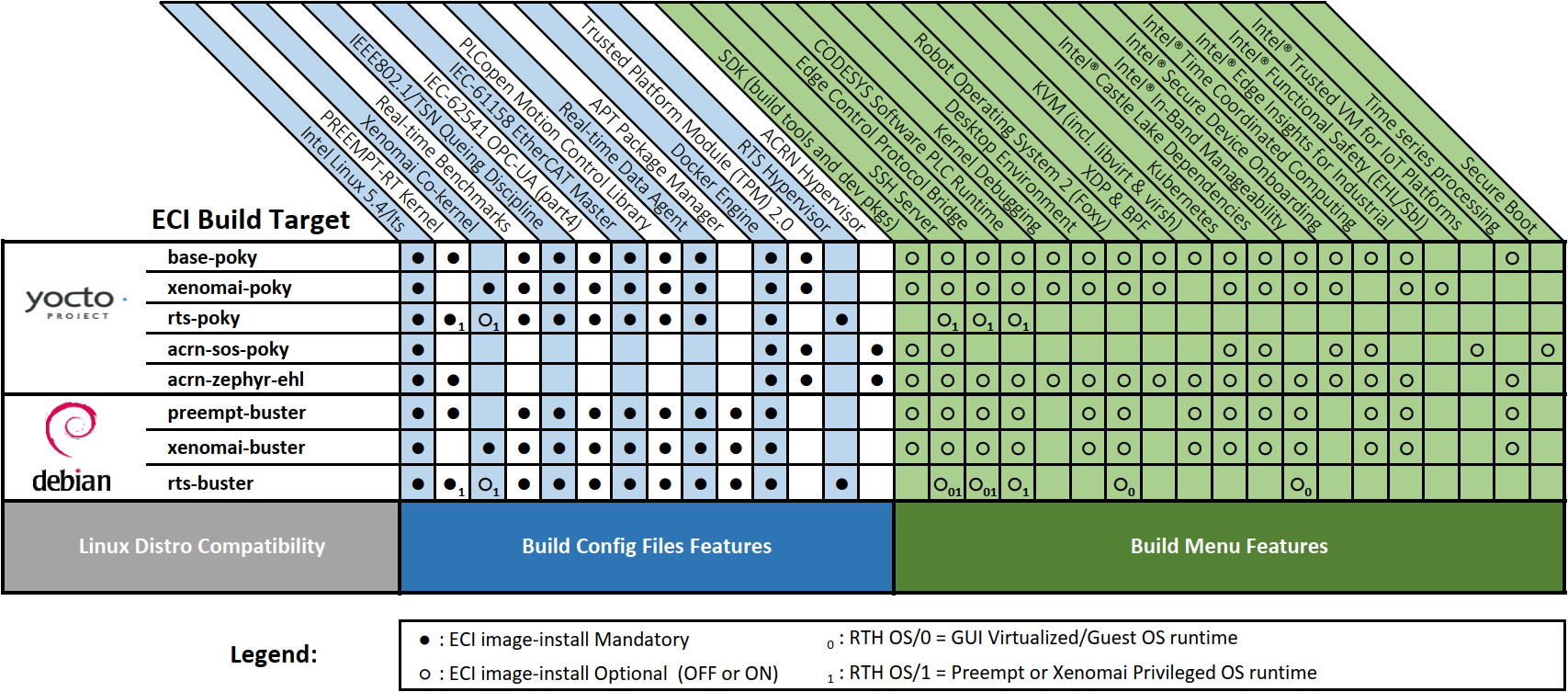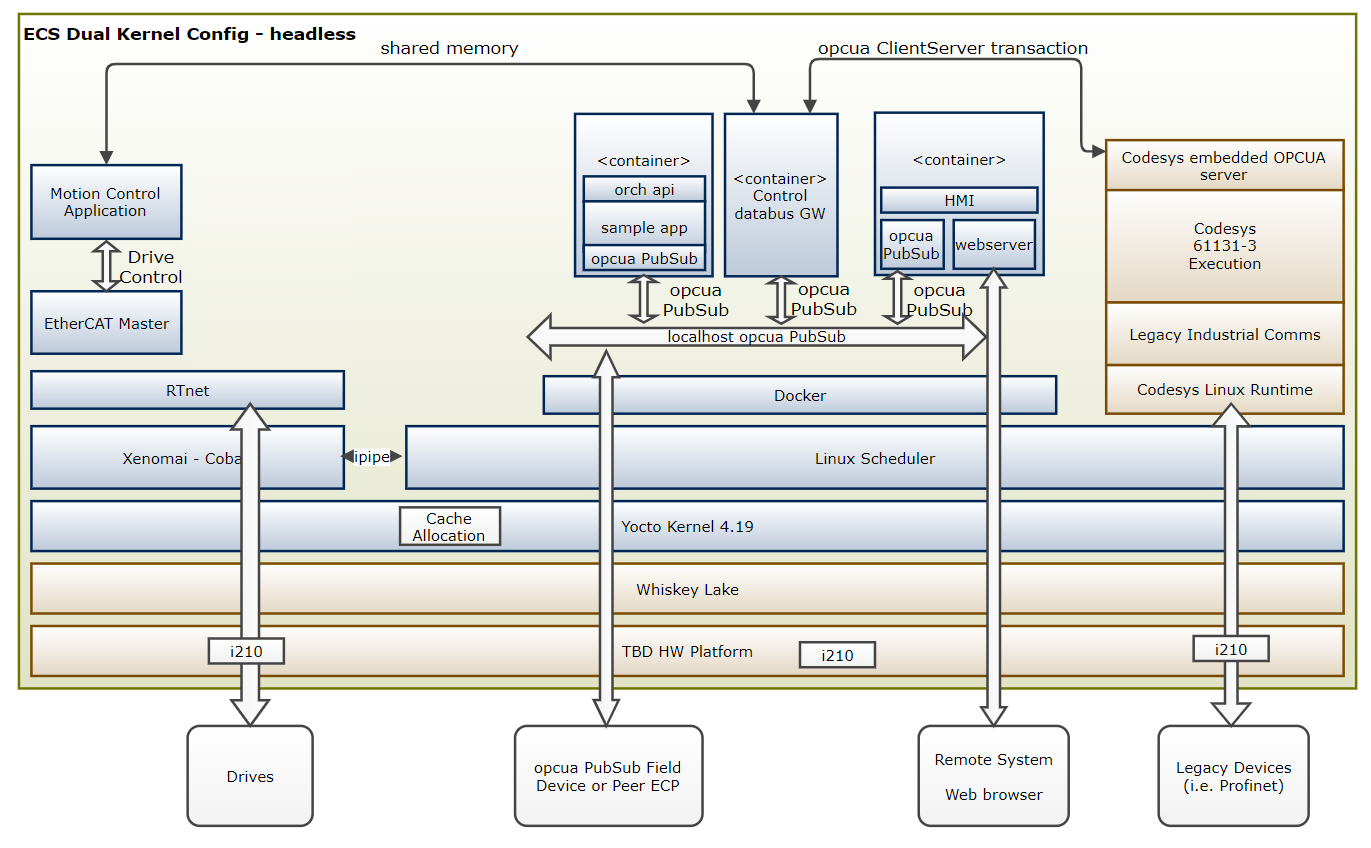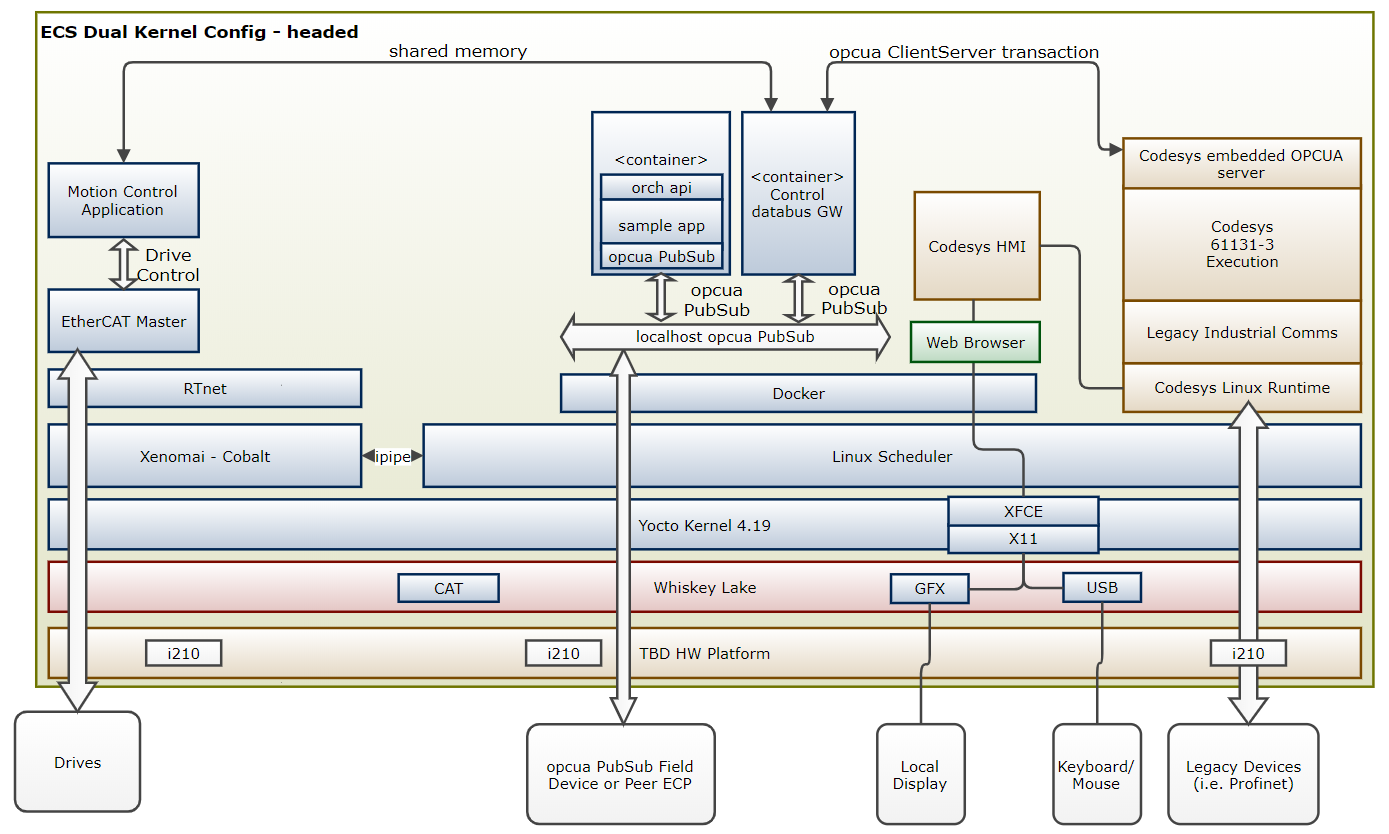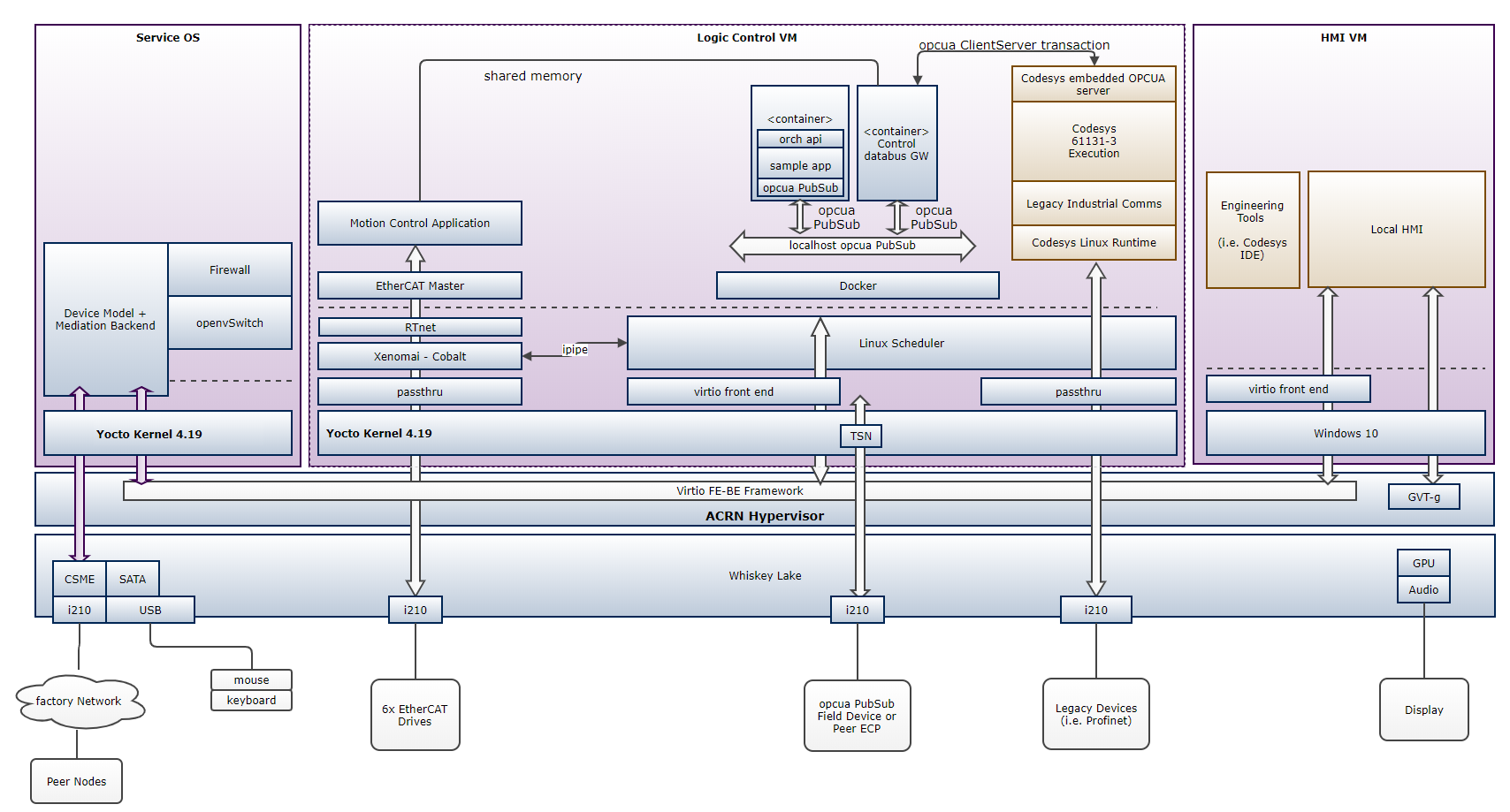About Intel® Edge Controls for Industrial¶
Intel® Edge Controls for Industrial (Intel® ECI) is a software reference platform with compatible hardware, which:
Enables you to move to a software-defined solution for controls; thus, providing better flexibility, higher levels of availability, and reduced costs
Integrates multiple workloads onto a single compute platform
Leverages the power and flexibility of various IT-style technologies, such as containerization, virtualization, and orchestration, to allow fixed function boxes to run as applications on an industrial PC (IPC)
Optimizes real-time computing performance
Intel ECI is very flexible and can be applied to a wide range of applications and end equipment. Currently, ECI focuses on three major groups:
Machine builders: ECI makes it possible to consolidate motion and logic control and provides a local user interface to monitor processes and enable supervisory controls. A platform management agent simplifies software updates and application provisioning.
Discrete automation (such as automotive manufacturing): ECI enables low-latency motion control and puts safety first. Using a fully managed infrastructure, the platform can securely onboard new nodes and update software.
Process automation (such as oil and gas industry): ECI allows control execution to be managed as containerized microservices. Using advanced orchestration techniques, the platform also improves redundancy with increased workload availability and portability.
The following are the key features of ECI:
Time Deterministic Compute Keeps industrial processes working predictably with deterministic compute using TSN implementation and Intel® TCC Technology |
Workload Convergence Uses virtualization and containerization configurations to consolidate mixed-criticality workloads |
Application and Platform Management Enables zero-downtime updates and enhanced maintainability, with increased flexibility due to real-time workload orchestration |
Infrastructure Management Scales control node clusters with software-defined infrastructure, including network, storage, and CPU |
Industrial Connectivity Bridges brownfield and greenfield communication technologies to achieve a complete edge-to-cloud solution |
Controls Application Offers production-verified and standards-compliant controls samples to simplify production and deployment |
Security Provides authentication and confidentiality capabilities that cover the entire computing environment, from chip to cloud |
Functional Safety Provides safety using capable tool chain and software, and built-in fault-tolerance mechanisms |
ECI Build Targets¶
ECI offers many variants, also known as targets. These targets are organized by their commonalities into groups which are referred to by an alias, such as: ECI-B, ECI-X, ECI-R, and ECI-A. See the table below for a list of ECI targets and their associated alias group.
Alias |
Description |
Target |
Distribution |
Kernel version |
|---|---|---|---|---|
ECI-B |
Linux PREEMPT_RT Base essential image |
Yocto Poky 3.1 Preempt-rt (Dunfell) |
v5.4.115-rt57 |
|
Debian 10 Linux Preempt-rt (Isar) |
v5.4.115-rt57 |
|||
ECI-X |
Linux Xenomai Cobalt/I-pipe essential image |
Yocto Poky 3.1 Xenomai (Dunfell) |
v5.4.115-ipipe |
|
Debian 10 Linux Xenomai (Isar) |
v5.4.115-ipipe |
|||
ECI-R |
Linux PREEMPT_RT and Xenomai Real-Time Systems Hypervisor (RTH) Multi-OS Consolidated System |
Virtual Debian 10 Desktop (Isar) |
v5.4.115 |
|
Privileged Debian 10 Preempt-rt (Isar) |
v5.4.115-rt57 |
|||
Privileged Debian 10 Xenomai (Isar) |
v5.4.115-ipipe |
|||
Privileged Yocto Poky Preempt-rt (Dunfell) |
v5.4.115-rt57 |
|||
Privileged Yocto Poky 3.1 Xenomai (Dunfell) |
v5.4.115-ipipe |
|||
ECI-A |
Linux ACRN Hypervisor |
Yocto Poky 3.1 ACRN custom (Dunfell) |
v5.4.115 |
|
Yocto Poky 3.1 Preempt-rt + ACRN (Dunfell) |
v5.4.115-rt57 |
ECI Prebuilt Images¶
To simplify using ECI, many targets are available prebuilt, and can be readily downloaded from this link. The tables below describe the options available.
ECI Prebuilt Images |
|---|
|
|
|
The following table lists the selected feature options of ECI prebuilt images:
ECI Core |
ECI Performance Native + KVM |
ECI Performance ACRN Vecow SPC-7100 TGL-i7 |
|
|---|---|---|---|
Hypervisor (ACRN) |
Yes |
||
Hypervisor (KVM) |
Yes |
||
Buster Preempt-RT (Debian) |
Yes |
Yes |
Yes |
SDK (build tools and development packages) |
Yes |
Yes |
Yes |
SSH-Server |
Yes |
Yes |
Yes |
EC Protocol Bridge |
Yes |
Yes |
Yes |
CODESYS Software PLC |
Yes |
Yes |
|
Intel® Secure Device Onboard (ACRN) |
Yes |
||
Castle Lake Dependencies |
Yes |
Yes |
|
Intel® In-Band Manageability |
Yes |
Yes |
Yes |
Intel® Time Coordinated Computing (Intel® TCC) |
Yes |
Yes |
Yes |
Intel EII |
Yes (+ Intel EII) |
Yes (+ Intel EII) |
|
Robotics Operating System 2 |
Yes (+ Robotics) |
Yes (+ Robotics) |
ECI Feature Matrix¶
The following figure shows the feature options available to each ECI target. Features listed under Build Config Files Features are always enabled, while Build Menu Features can be enabled/disabled during the image build process.
Note
The feature options shown in the feature matrix are selectable when building a custom ECI image locally.

ECI Architecture Diagrams¶
The following architecture diagrams detail the component relationships in ECI:
ECI Base Architecture¶

ECI Xenomai Architecture¶

ECI Xenomai (with x11 Windowing System) Architecture¶

ECI ACRN Architecture¶

ECI Kernel and Boot Optimizations¶
For a list of kernel configurations and boot parameters used to optimize the ECI, refer to ECI Kernel Configuration Optimizations and ECI Kernel Boot Optimizations